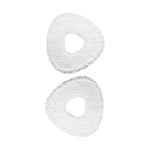Yes, they can, but only if equipped with the right technology. Uneven surfaces like raised thresholds, bumps, and sloped tiles can challenge a vacuum’s ability to clean consistently and without interruption.
In this guide, we’ll explain how robot vacuums navigate uneven floors using advanced sensors, smart mapping, and adaptive components. You’ll learn the common obstacles these devices face and what performance features to look for—such as climbing height, floating brushes, or edge detection—that ensure smooth transitions and thorough cleaning.
We also compare the best robot vacuums for uneven floors and share practical tips to improve cleaning efficiency in real homes. Whether you’re dealing with mixed flooring, pet hair, or tricky layouts, this article will help you choose the right model and optimize its performance with minimal effort.
How Do Robot Vacuums Navigate Uneven Floors?
Robot vacuums use advanced technology to navigate uneven floors. They rely on sophisticated navigation systems, sensors, and mapping techniques to move around and clean efficiently. These technologies help them detect and avoid obstacles, adjust to changes in floor height, and create accurate maps of their surroundings.
Navigation technology
Robot vacuums are equipped with navigation technology that helps them move around your home efficiently. This technology often includes gyroscopes and accelerometers, which allow the vacuum to detect changes in orientation and movement. These components work together to ensure the vacuum can navigate over small bumps and thresholds without getting stuck.
Additionally, some high-end models use more advanced systems, such as simultaneous localization and mapping (SLAM), to navigate complex environments more effectively.
Sensors and mapping
Sensors play a crucial role in helping robot vacuums navigate uneven floors. Mapping the surroundings is often done with camera-based systems and LIDAR technology.
LIDAR systems measure distances and produce a comprehensive map of the space using laser beams, whilst camera-based systems take pictures to comprehend the arrangement. These mapping techniques enable the vacuum to plan its cleaning path, avoid obstacles, and adjust to changes in floor height. Accurate mapping ensures that the vacuum can cover the entire floor surface, even if it is uneven.
Obstacle detection
Obstacle detection is another essential feature that helps robot vacuums navigate uneven floors.
In order to prevent falls, edge detection sensors enable the vacuum to identify and avoid edges, such as stairs. Cliff sensors, which are typically located at the bottom of the vacuum, detect sudden drops and ensure the device changes direction to avoid falling off ledges.
These sensors help the vacuum navigate safely and effectively, even in homes with uneven floors.
Challenges Robot Vacuums Face on Uneven Floors
Uneven floors can make it tough for robot vacuums to do their job effectively. These surfaces often include cracks, bumps, or varying textures, which can range from slightly raised thresholds between rooms to more noticeable slopes and uneven tiles. Such variations in floor height and texture create significant obstacles for robot vacuums.
One of the most common issues faced by robot vacuums on uneven floors is getting stuck on thresholds. Many homes have small thresholds or transitions between different types of flooring, and robot vacuums might get stuck on these raised edges. This interrupts their cleaning cycle and often requires manual intervention to free the device.
Additionally, robot vacuums can have difficulty climbing over small bumps. Even minor obstacles can pose significant challenges, as these devices might struggle to navigate over them. This difficulty can prevent the vacuum from reaching and cleaning certain areas of your home, leading to missed spots and incomplete cleaning sessions.
Sloped or inclined surfaces present another challenge for robot vacuums. These surfaces can affect the vacuum's ability to maintain proper suction and cleaning efficiency. The vacuum might slip or miss spots, resulting in uneven cleaning results.

What to Look for in a Robot Vacuum for Uneven Floors
What should you look for in a robot vacuum for uneven floors? Prioritize models with smart navigation, adjustable brushes, high threshold climbing, adaptive suction, durable construction, and zone-based cleaning. These features ensure smooth operation across bumps, slopes, and transitions.
Smart Navigation and Mapping
Effective navigation is essential for dealing with uneven floors. Look for models equipped with LIDAR sensors or AI-powered cameras that can scan the environment, detect floor height changes, and adapt routes accordingly.
Advanced features like multi-level mapping, fall prevention, and anti-collision sensors help the vacuum avoid stairs, furniture legs, and unpredictable drops—minimizing disruption and manual intervention.
Adjustable and Tangle-Free Brush System
A floating main brush adjusts its height automatically to maintain consistent floor contact—even on sloped or textured surfaces.
Brushes with anti-tangle technology prevent hair and debris buildup, keeping performance consistent. Some models also include edge-cleaning enhancements that adjust brush angles to hug walls and baseboards more effectively, especially where edges are not perfectly flat.
Threshold and Obstacle Handling
Transitions between rooms or flooring types often include slight elevations. A vacuum that can climb at least 20–25mm is essential for uninterrupted cleaning across raised edges, rugs, or tiles.
Look for rugged wheels with built-in suspension, which help stabilize the vacuum and absorb shock when crossing cracks or bumps.
Additionally, quiet operation on hard or elevated surfaces helps minimize noise—especially helpful in homes with pets, children, or light sleepers.
Adaptive Suction and Cleaning Modes
Uneven floors often involve varying materials—tile, wood, carpet—with different cleaning needs. A robot vacuum with automatic suction adjustment and mop lifting can seamlessly adapt between surface types.
When carpet is detected, the mop lifts to avoid dampening, and suction increases to extract embedded debris. Some models also allow manual suction control for targeted deep cleans in difficult areas like grout lines or textured tile.
Durable Design for Uneven Conditions
Irregular surfaces can wear out vacuum components faster. Choose models with anti-slip chassis, scratch-resistant housing, and reinforced wheels to handle rough transitions without damage.
For larger or multi-level homes, a long battery life (200+ minutes) and smart recharge-and-resume function ensures uninterrupted cleaning, even when coverage areas are complex or include many obstacles.
Targeted Cleaning Zones
The ability to set custom cleaning zones is particularly useful for uneven layouts. It allows you to direct the vacuum toward problem areas—like entryways with raised tiles—or avoid zones where it may struggle, such as high-pile rugs or steep thresholds.
This level of control helps maximize cleaning efficiency while reducing the need for supervision.
Best Robot Vacuums for Uneven Floors
Looking for the best robot vacuum for uneven floors? This section compares top-performing models from Narwal—including Flow, Freo Z10 Ultra, and Freo Z Ultra—built to navigate thresholds, bumps, and irregular surfaces with ease.
Narwal Flow
[cta:narwal-flow-robot-vacuum-mop]
Narwal Flow is designed to handle uneven flooring with precision. Its 22,000Pa suction power extracts debris from textured tiles, deep crevices, and cracked surfaces.
The FlowWash mopping system keeps the mop clean during every pass using 113°F warm water and 12N of pressure, ideal for tackling grime stuck in irregular surfaces.
It easily crosses 1.6-inch (40mm) thresholds—such as between rooms or at balconies—without getting stuck. The dual RGB cameras and onboard AI recognize over 200 types of obstacles, adjusting its route in real time to avoid bumps, cords, or pet bowls on uneven terrain.
When carpet is detected, the mop lifts 12mm to stay dry and avoid dragging over higher-pile surfaces.
Narwal Freo Z10 Ultra
[cta:narwal-freo-z10-ultra-intelligent-in-mind-deep-in-clean]
Freo Z10 Ultra combines AI vision navigation and 18,000Pa suction, delivering effective cleaning even across thresholds, bumps, and floor transitions.
Its EdgeReach™ triangular mop extends and twists to maintain contact with floor edges and baseboards—even on sloped or warped surfaces.
On uneven carpets or hard floors, it auto-lifts the mop and adjusts suction in real time for optimal cleaning performance. The robot senses dirt level and responds accordingly, ensuring no area is skipped due to floor height differences.
Narwal Freo Z Ultra
[cta:narwal-freo-z-ultra-robotic-vacuum-and-mop-cleaner-clean-before-you-even-notice]
Designed for homes with complex layouts, Freo Z Ultra adapts seamlessly to uneven floor heights. Its floating brush maintains close contact with bumpy or sloped flooring, while 12,000Pa suction removes embedded debris and pet hair.
The dual-mop system applies 2 lbs of pressure at 180 RPM, ideal for textured tiles or raised grout lines.
Using dual HD cameras and AI chips, it avoids low-profile obstacles and transitions smoothly over uneven sections. With EdgeSwing™ technology, it reaches into corners and along baseboards—even when the floor surface isn’t flat.
How to Choose Based on Your Floor Type
If your home has deep grout lines, textured tile, or elevated thresholds, the Narwal Flow offers the strongest suction and climbing capability, ideal for aggressive debris removal across complex surfaces.
For homes with a mix of carpets and uneven hard floors, the Freo Z10 Ultra balances strong suction and precise edge mopping, making it suitable for families with pets or children.
If quiet performance and automatic dirt detection matter most—especially in large, multi-room layouts with gentle slopes—the Freo Z Ultra is a reliable, intelligent all-rounder.
Tips to Improve Robot Vacuum Cleaning on Uneven Floors
Optimizing your robot vacuum’s performance on uneven floors involves proper maintenance, setup tips, and using the right accessories and settings.
Maintenance and setup tips
To keep your robot vacuum performing well on uneven floors, regular maintenance and proper setup are crucial. Here are some tips:
-
Regular Cleaning of Sensors and Wheels: Dust and debris can accumulate on sensors and wheels, affecting the vacuum’s navigation and cleaning efficiency. Regularly clean these parts with a dry cloth to ensure they function correctly.
-
Ensuring Proper Firmware Updates: Manufacturers often release firmware updates to improve performance and fix bugs. Regularly check for and install these updates to keep your vacuum running smoothly.
-
Setting Up the Charging Dock: Place the charging dock in an accessible, flat area free from obstacles. This ensures the vacuum can easily find its way back to recharge without getting stuck on uneven surfaces.
-
Using Ramps for Thresholds: If your home has high thresholds that the vacuum struggles to cross, consider using small ramps. These ramps can help the vacuum transition smoothly between different floor levels.
-
Monitoring Battery Health: Keep an eye on your vacuum’s battery health. Avoid letting the battery drain completely and try to keep it charged above 20%. If the battery shows signs of wear, consider replacing it to maintain optimal performance.
Recommended accessories and settings
Using the right accessories and settings can significantly enhance your robot vacuum’s ability to handle uneven floors. Here are some recommendations:
-
Virtual Walls and No-Go Zones: Many robot vacuums come with virtual wall features or the ability to set no-go zones. Make use of these functions to keep the vacuum out of places where it could become trapped or have problems.
-
High-Threshold Climbing Wheels: Some vacuums offer upgraded wheels designed to handle higher thresholds and uneven surfaces. Consider models or accessories that include these features to improve navigation.
-
Custom Cleaning Modes: Take advantage of custom cleaning modes that adjust the vacuum’s performance based on the floor type. For example, use a mode that increases suction power on carpets and reduces it on hard floors to enhance cleaning efficiency.
-
Adjustable Suction Power: Some vacuums allow you to adjust the suction power manually. Increase the suction on uneven or textured surfaces to ensure a thorough clean.
Regular Maintenance Accessories: Use maintenance kits that include brushes, filters, and cleaning tools specifically designed for your robot vacuum model. Regularly replacing worn-out parts keeps your vacuum in top condition.

Conclusion
Robot vacuums can handle uneven floors if you choose the right one. Models like the Narwal Flow, Freo Z10 Ultra, and Freo Z Ultra offer advanced navigation, adaptive cleaning features, and strong climbing capabilities to tackle thresholds, bumps, and textured surfaces with ease.
With proper maintenance, setup, and feature selection, you can keep your entire home clean without worrying about floor height differences.
Ready to find the right model for your home? Explore our best robot vacuums for uneven floors or visit Narwal Australia to learn more.




















































